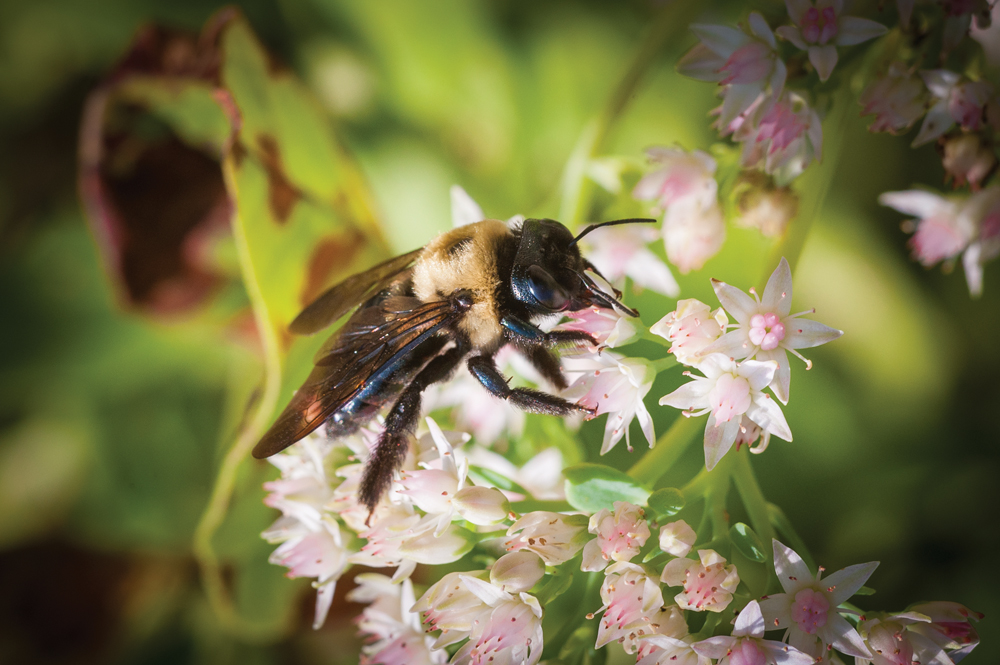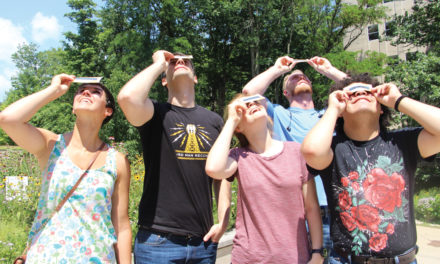
A bumblebee at Brown County State Park. Photo by Rodney Margison
BY SUSAN M. BRACKNEY, CITIZEN SCIENTIST
His face patina-ed with sweat and panic, I recently watched as my neighbor hopped around inside his screened porch swatting a couple of “bumblebees” which had gained entry. To his credit, he was trying to protect his mother who is purportedly allergic to bee stings. But one look at the insects’ shiny abdomens revealed a sad truth. Not only were these carpenter bees, but they were most likely male and therefore stingless. I will admit, carpenter bees can be a nuisance. They’ll drill into unfinished wood faster than TV’s Bob Vila. And the males can certainly act aggressive, but it’s a show largely meant for other carpenter bees.
Head-to-toe fuzzy and similarly loud, bumblebees have the misfortune of looking like carpenter bees, but they’re very beneficial. We’ve similarly allowed lookalike yellow jackets to wreck the virtuous honey bee’s reputation.
Because they’re prolific pollinators upon which modern agriculture relies, our beleaguered honey bees have received ample media attention and research dollars. But our native bumblebee populations are also declining—due to natural habitat loss, climate change, and exposure to pesticides and pathogens from commercially reared bumblebees used in greenhouses.
Tomato and blueberry crops both require “buzz pollination”—something honey bees can’t do. Have you ever heard what sounds like a bumblebee stuck inside a flower? It’s actually quite intentional. That buzzing causes intractable flowers to yield their pollen.
Although bumblebees haven’t garnered the attention of dwindling honey bee populations, citizen scientists like me are making up the difference through initiatives such as Bumble Bee Watch.
When I hear a large bee’s low-frequency buzz, I whip out my camera’s macro lens. I carry it with me for just such occasions because it allows me to take super-up-close photos of tiny things like bees. From the more common “black and gold” and “half-black” bumblebees to less common “Sanderson,” “yellow,” and “American” varieties, I’m always on the lookout for the 17 or so species we can expect to find in Monroe County. Some of my personal obsessions include the very rare “yellow-banded,” “Ashton’s cuckoo,” and the endangered “rusty-patched” bumblebees.
If I think a bumblebee is female, I’ll snap some close-ups, upload them to the Bumble Bee Watch website, and suggest an identification. For example, compared to males, females look like they’re wearing bell bottoms. Also, they have six abdominal segments instead of seven, and 12 antenna segments rather than 13. Official Bumble Bee Watch experts later verify all submissions.
It’s important to remember that, unlike males, female bumblebees can sting—repeatedly. But I haven’t been stung by one yet. Still, if you’d rather help the bees from a distance, you can do so by avoiding the use of pesticides and planting native flowers like common milkweed, Virginia bluebells, Joe-Pye weed, cardinal flower, and bee balm.
For more information on how you can become a part of the Bumble Bee Watch, visit bumblebeewatch.org.
Susan M. Brackney is the author of four nonfiction books, including Plan Bee: Everything You Ever Wanted to Know About the Hardest-Working Creatures on the Planet (Perigree Books).
Her work has appeared in such publications as The New York Times, Discover, Organic Gardening, andHobby Farms.





